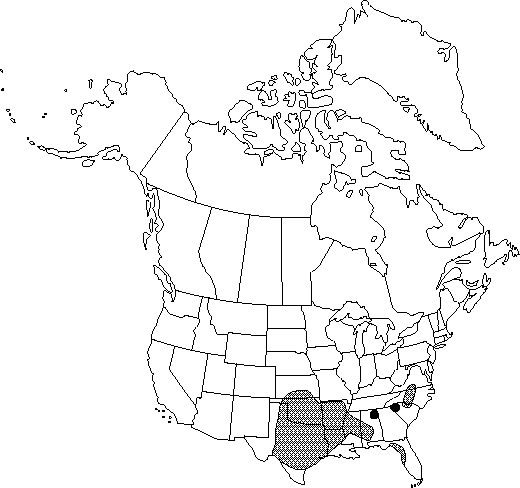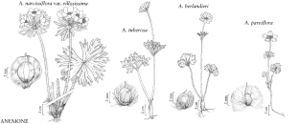Anemone berlandieri
Linnaea 15: 628. 1841.
Aerial shoots (10-)30-50 cm, from tubers, rarely also from rhizomes, tubers vertical, rarely ascending. Basal leaves (1-)3-6(-9), 1-(nearly 2)-ternate; petiole 3-20 cm; terminal leaflet sessile, rarely petiolulate, ovate to obovate, 1-3(-6) × (0.4-)0.7-3(-4) cm, base broadly cuneate, margins crenate to serrate on distal 1/2, rarely on distal 2/3, apex obtuse to broadly acute, surfaces pubescent; lateral leaflets unlobed or 1×-lobed or -parted; ultimate lobes (6-)8-12 mm wide. Inflorescences 1-flowered; peduncle villous; involucral bracts 3, borne above middle of scape at anthesis, 1-tiered, simple, dissimilar to basal leaves, obtriangular, 3-cleft, (1-)1.5-4(-5) cm, bases clasping, ±connate, margins incised throughout, apex narrowly acute to acuminate, surfaces pilose; segments primarily 3, broadly linear; lateral segments unlobed or occasionally 1×-lobed; ultimate lobes 1.5-2.5 mm wide. Flowers: sepals (7-)10-17(-25), abaxially blue to violet, adaxially white, linear-oblong, rarely narrowly elliptic, (10-)15-20 × 2-3(-4) mm, abaxially hairy, especially toward base, adaxially glabrous or hairy toward base; stamens 60-70. Heads of achenes cylindric; pedicel (7-)9-15(-28) cm. Achenes: body elliptic, flat, 2.7-3.5 × 2.2-2.5 mm, not winged, densely white-woolly; beak subulate, curved, 1-2.3 mm, hidden in achene indument, white tomentose, not plumose. 2n=16.
Phenology: Flowering winter–spring (Feb–Apr).
Habitat: Open grasslands, prairies, hillsides, often limy substrate, also woods over thin shale
Elevation: 60-1100m
Distribution

Ala., Ark., Fla., Kans., La., Miss., N.C., Okla., S.C., Tex., Va., n Mexico.
Discussion
Selected References
None.
